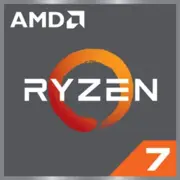AMD Ryzen 7 5800 vs Apple M1 Ultra
CPU Comparison Result
Below are the results of a comparison of AMD Ryzen 7 5800 and Apple M1 Ultra processors based on key performance characteristics, as well as power consumption and much more.
Advantages
- Higher Performance-core Max Turbo Frequency: 4.6 GHz (4.6 GHz vs 3.2 GHz)
- More Total Cores: 20 (8 vs 20)
- Higher Technology: 5 nm (7 nm vs 5 nm)
- Higher Memory Type: LPDDR5-6400 (DDR4-3200 vs LPDDR5-6400)
- Newer Launch Date: March 2022 (January 2021 vs March 2022)
Basic
AMD
Label Name
Apple
January 2021
Launch Date
March 2022
Desktop
Platform
Desktop
Ryzen 7 5800
Model Name
?
The Intel processor number is just one of several factors - along with processor brand, system configurations, and system-level benchmarks - to be considered when choosing the right processor for your computing needs.
M1 Ultra
Vermeer
Code Name
-
CPU Specifications
8
Total Cores
?
Cores is a hardware term that describes the number of independent central processing units in a single computing component (die or chip).
20
16
Total Threads
?
Where applicable, Intel® Hyper-Threading Technology is only available on Performance-cores.
20
8
Performance-cores
20
3.4 GHz
Performance-core Base Frequency
2.0 GHz
4.6 GHz
Performance-core Max Turbo Frequency
?
Maximum P-core turbo frequency derived from Intel® Turbo Boost Technology.
3.2 GHz
64K per core
L1 Cache
192K per core
512K per core
L2 Cache
24MB shared
32MB shared
L3 Cache
-
AM4
CPU Socket
?
The socket is the component that provides the mechanical and electrical connections between the processor and motherboard.
Apple M-Socket
100MHz
Bus Frequency
-
34x
Multiplier
-
Yes
Unlocked Multiplier
-
7 nm
Technology
?
Lithography refers to the semiconductor technology used to manufacture an integrated circuit, and is reported in nanometer (nm), indicative of the size of features built on the semiconductor.
5 nm
65 W
TDP
120 W
95 °C
Max. Operating Temperature
?
Junction Temperature is the maximum temperature allowed at the processor die.
-
4.0
PCIe Version
?
PCI Express is a high-speed serial computer expansion bus standard used for connecting high-speed components, replacing older standards such as AGP, PCI, and PCI-X. It has gone through multiple revisions and improvements since its initial release. PCIe 1.0 was first introduced in 2002, and in order to meet the growing demand for higher bandwidth, subsequent versions have been released over time.
-
x86-64
Instruction Set
?
The instruction set is a hard program stored inside the CPU that guides and optimizes CPU operations. With these instruction sets, the CPU can run more efficiently. There are many manufacturers that design CPUs, which results in different instruction sets, such as the 8086 instruction set for the Intel camp and the RISC instruction set for the ARM camp. x86, ARM v8, and MIPS are all codes for instruction sets. Instruction sets can be extended; for example, x86 added 64-bit support to create x86-64. Manufacturers developing CPUs that are compatible with a certain instruction set need authorization from the instruction set patent holder. A typical example is Intel authorizing AMD, enabling the latter to develop CPUs compatible with the x86 instruction set.
-
Memory Specifications
DDR4-3200
Memory Type
?
Intel® processors come in four different types: Single Channel, Dual Channel, Triple Channel, and Flex Mode. Maximum supported memory speed may be lower when populating multiple DIMMs per channel on products that support multiple memory channels.
LPDDR5-6400
128GB
Max Memory Size
?
Max memory size refers to the maximum memory capacity supported by the processor.
128GB
2
Memory Channels
?
The number of memory channels refers to the bandwidth operation for real world application.
16
51.2 GB/s
Max Memory Bandwidth
?
Max Memory bandwidth is the maximum rate at which data can be read from or stored into a semiconductor memory by the processor (in GB/s).
-
Yes
ECC Memory Support
-
GPU Specifications
N/A
Integrated Graphics Model
?
An integrated GPU refers to the graphics core that is integrated into the CPU processor. Leveraging the processor's powerful computational capabilities and intelligent power efficiency management, it delivers outstanding graphics performance and a smooth application experience at a lower power consumption.
True
Miscellaneous
20
PCIe Lanes
-
Benchmarks
Cinebench R23 Single Core
Ryzen 7 5800
1603
+4%
Apple M1 Ultra
1538
Cinebench R23 Multi Core
Ryzen 7 5800
14340
Apple M1 Ultra
23314
+63%
Geekbench 6 Single Core
Ryzen 7 5800
2051
Apple M1 Ultra
2390
+17%
Geekbench 6 Multi Core
Ryzen 7 5800
9507
Apple M1 Ultra
18219
+92%
Geekbench 5 Single Core
Ryzen 7 5800
1658
Apple M1 Ultra
1768
+7%
Geekbench 5 Multi Core
Ryzen 7 5800
9390
Apple M1 Ultra
23501
+150%
Passmark CPU Single Core
Ryzen 7 5800
3394
Apple M1 Ultra
3868
+14%
Passmark CPU Multi Core
Ryzen 7 5800
25837
Apple M1 Ultra
41184
+59%
Blender
Ryzen 7 5800
208
Apple M1 Ultra
407
+96%









